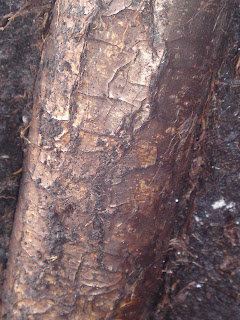I've been studying Historical archaeology for 5 years at the Institute of archaeology in Lund. I became interested in building archaeology quite early and later on I wrote my master-thesis (magisteruppsats) on a medieval church called Borrie. I have also taken some theology, and last semester geology. I currently work as a guide at Dunkers in Helsingborg. I have excavated in Vallåkra and Uppåkra, and done building archaeological studies of Borrie church, Bonderup church and Malmöhus castle.
Before Rönneholm I never really cared about the stone age. Well, consider that opinion changed for life!
The hunter-gatherer culture is extremely fascinating when you get to see it in the way Rönneholm peat bog displays it. I mean, to get a glimpse of an hours activity that happened 7000 years ago is really quite rare and when you hear the experts talk about their interpretations, you're hooked for life.
My first two weeks started with surveys and fieldwalks. Talk about a good way to start an excavation. Who knew there was gonna be more than four bone-points with my name on them. The weeks after that it was most measuring with the total station, but it gives you great experience and it's a knowledge you must have as an archaeologist.
Then finally I could start digging. For every pull with the trowel something really good can turn up, and that feeling keeps you going. Archaeologists love to find stuff. However, it was really interesting also to see the geology of the place. The bog was from the beginning a lake, but with sediments and nutrients from the surroundings the natural step is that the lake overgrows into a bog. The second layer from the bottom reveals that the environment was very rich on nutrients, otherwise the algaegyttja wouldn't be there. After the gyttja the lake overgrows with reeds and sedge, and finally it's covered with
Sphagnum
The best things with Rönneholm was of course all the new people you got to meet, but also the hard work and the experience gained from working on a real excavation. And of course learning to identify flints, bone, arrowheads and wetstones! Here are 9 pictures from the last 5 weeks:
 |
| Using the rain and the "muk" to figure out how the ditches form. |
 |
| Archaeology is all about working together |
 |
| The best survey team I believe |
 |
| "Let's take the post hole home with us!" |
 |
This is archaeology in a nut shell
|
 |
| Aerial photography |
 |
| My best find |
 |
| My best trench |
 |
The normal work place for an archaeologist
|
/Text and photos by Erik Johansson










































